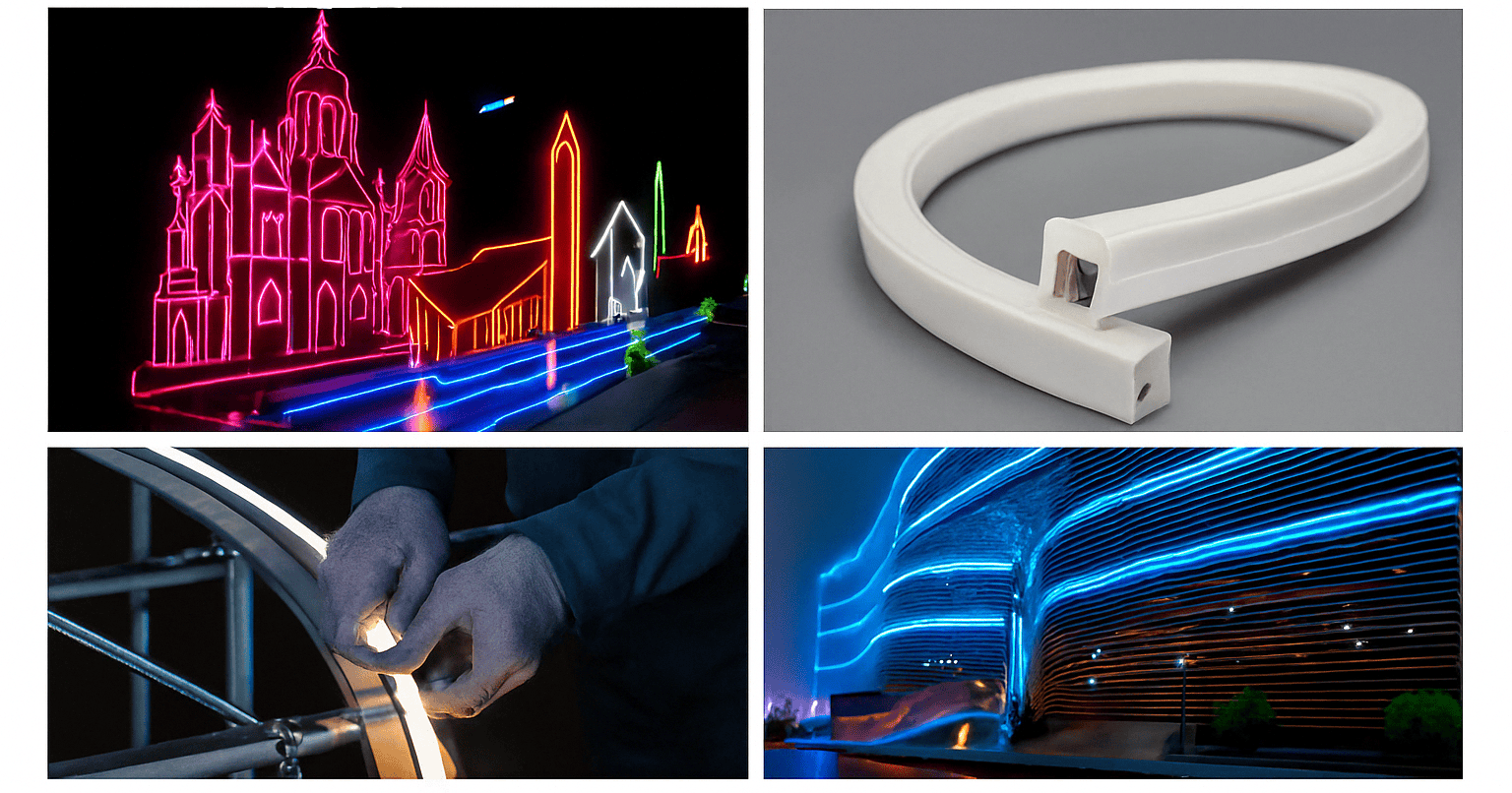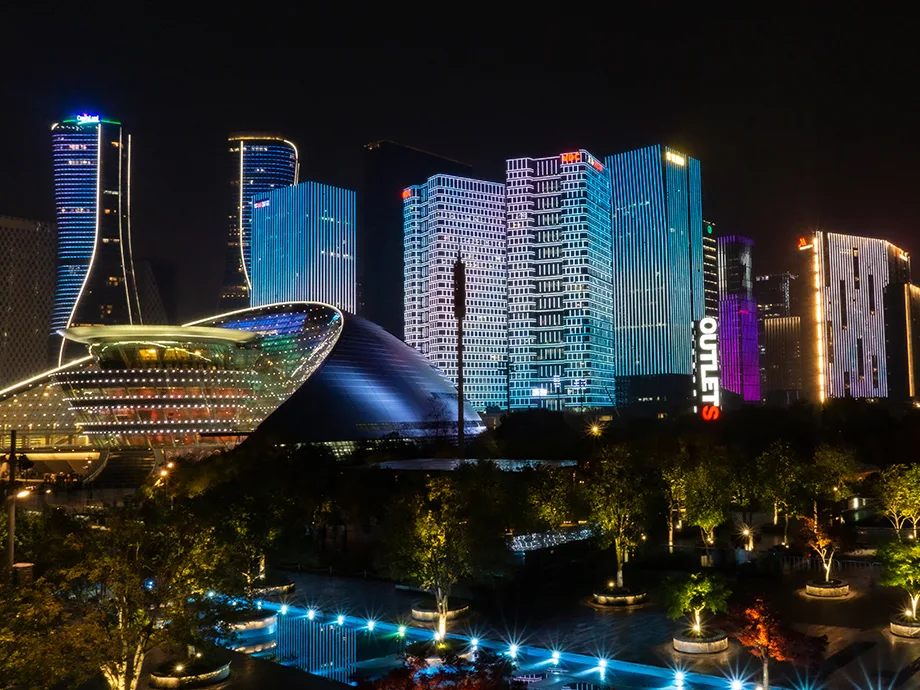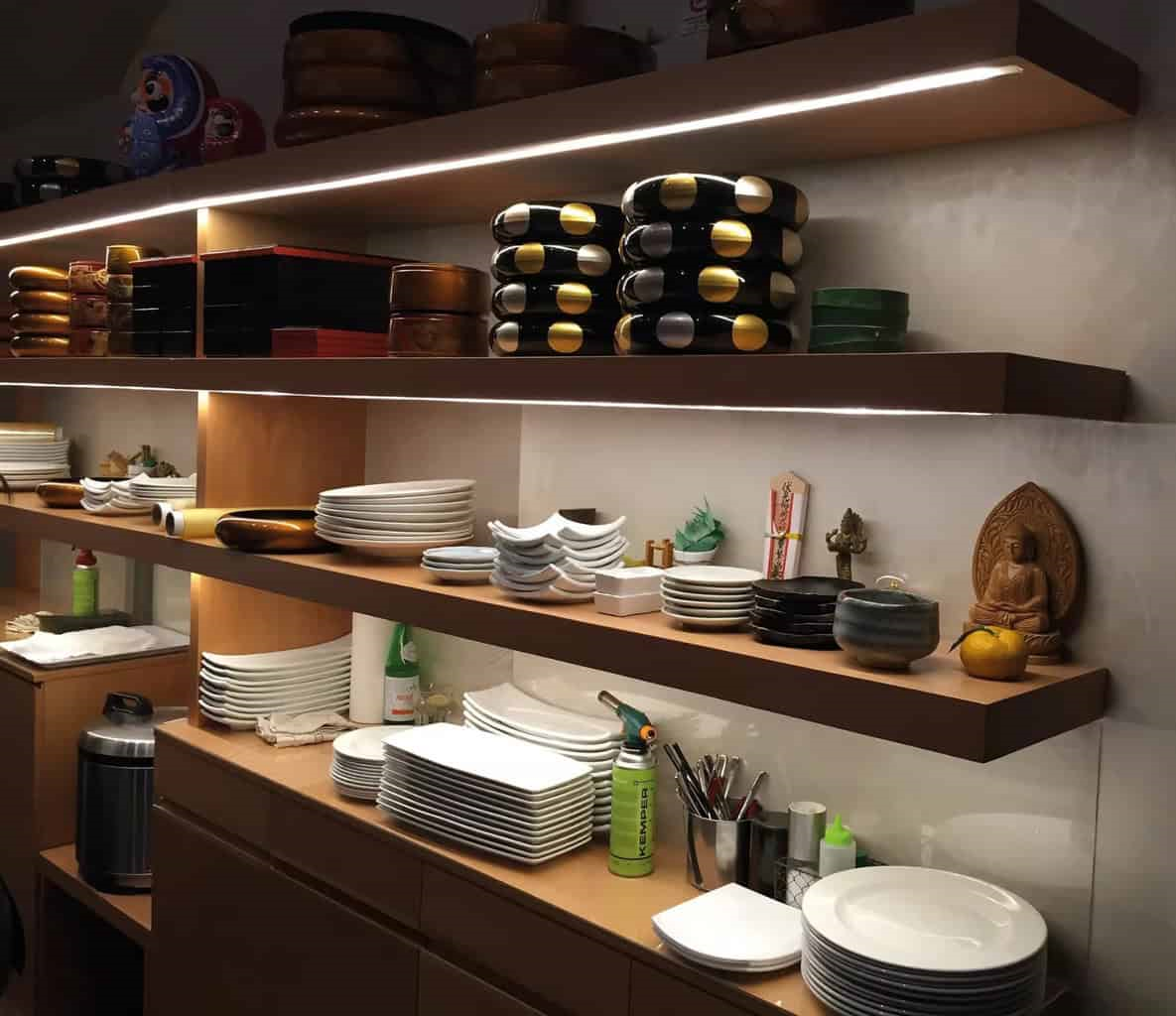As LED lighting technology continues to evolve, lighting professionals, designers, and contractors are faced with an expanding range of solutions for both indoor and outdoor applications. Among the most widely used and visually impactful options are LED neon strips and standard LED strip lights. Though they may appear similar at first glance, their performance, design, and installation capabilities differ significantly.
Understanding these differences is essential when selecting the ideal lighting system for projects such as architectural facades, signage outlines, landscape features, or modern interiors. The right choice can affect not only the visual appeal, but also the durability, control flexibility, and long-term maintenance of your lighting setup.
In this guide, we’ll compare LED neon flex and LED strip lights across key aspects including construction, light quality, bending direction, waterproof ratings, control systems, installation, and use cases. Whether you’re designing a glowing logo, outlining a building with ambient light, or enhancing a retail display, this breakdown will help you choose the most suitable option for your lighting goals.
What is LED Neon Flex? (Seamless Lighting for Outdoor & Signage Use)
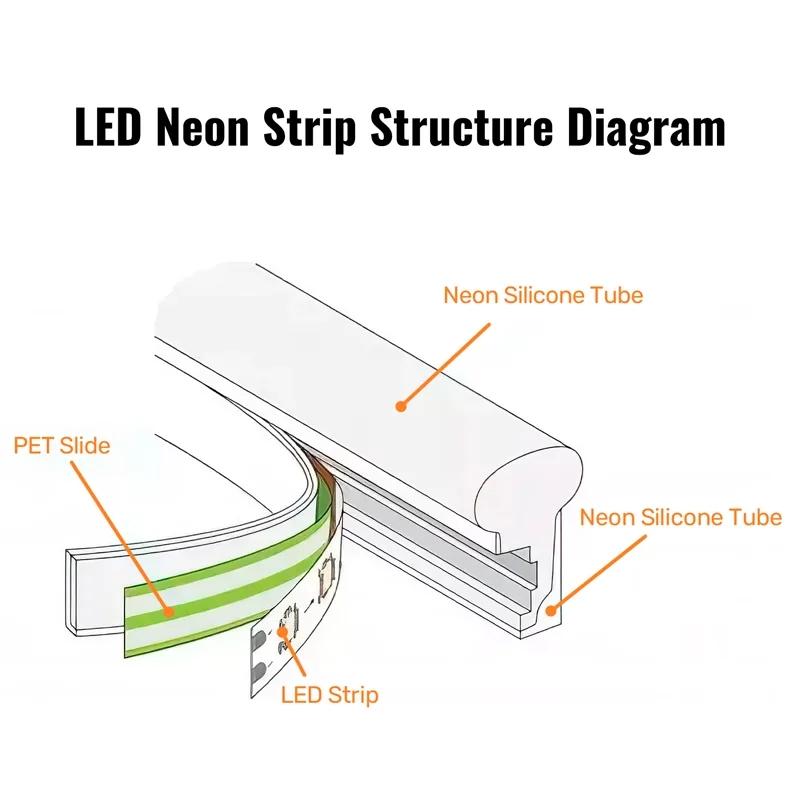
1. Definition and Structure:
LED Neon Flex is a modern linear lighting solution designed to mimic the iconic glow of traditional glass neon lights, while offering the superior efficiency, safety, and flexibility of LED technology. Unlike conventional LED strip lights, which expose individual diodes, LED Neon Flex encases its LED chips within a flexible, robust silicone or PVC housing. This encapsulated design includes a built-in diffusion layer that eliminates visible light points and produces a seamless, continuous glow along the length of the fixture.
The internal structure of an LED Neon Flex typically features high-density SMD or COB LED chips mounted on a flexible circuit board, which is then encased through an extrusion molding process. The material not only serves as a light diffuser but also acts as protection against moisture, dust, UV rays, and physical impact. This results in a lighting product that is not only visually striking but also highly durable—ideal for both indoor and outdoor applications where performance and reliability are critical.
2. Bending Directions and Design Variants:
A key feature of LED Neon Flex is its ability to bend in specific directions, making it highly suitable for custom shapes and creative architectural elements. There are generally three types of bending capabilities:
Top-Bend: Allows for vertical (up and down) bending. This type is ideal for lettering, logos, or installations where the light needs to curve around vertical surfaces.
Side-Bend: Offers horizontal (left to right) flexibility, making it perfect for outlining facades, following building contours, or wrapping around corners.
3D Omni-Bend: Provides multidirectional flexibility, allowing it to bend in both top and side directions, ideal for complex 3D structures or artistic light sculptures.
Designers and lighting engineers select the bending type based on installation constraints and the desired visual outcome, ensuring both technical feasibility and aesthetic consistency. Choosing the correct type ensures a smoother installation process and enhances the consistency of the lighting output.
3. Light Distribution and Visual Performance:
One of the most significant advantages of LED Neon Flex is its dot-free illumination. Thanks to its integrated optical diffuser, the light output appears as a uniform line of light—free from the hotspots commonly found in standard LED strips. This makes it the ideal choice for high-end applications where a clean, continuous lighting line is desired, such as in signage, architectural outlines, or luxury retail displays.
Available in various cross-sectional shapes—such as flat-top, dome-top, or side-glow—LED Neon Flex can be tailored to match specific visual or structural requirements. Beam angles range widely, with standard models offering 120° to 270° light dispersion, and some products capable of omnidirectional lighting for maximum coverage.
In terms of light types, LED Neon Flex supports a wide spectrum of options, including single-color (white, warm white, amber, etc.), tunable white (dynamic CCT), RGB, RGBW, and addressable RGB digital versions. These variations offer immense flexibility for static or dynamic lighting schemes, from subtle accents to full-scale animated effects.
4. Environmental Durability and Performance:
LED Neon Flex is designed with long-term, real-world durability in mind. Most products are rated IP67 or IP68, which means they are fully protected against dust and can withstand temporary or continuous water immersion. This makes them exceptionally suitable for outdoor installations, wet environments, or regions with extreme weather conditions.
Advanced UV-resistant materials prevent yellowing or degradation due to prolonged sun exposure, ensuring color consistency and longevity. High-quality models operate efficiently across a broad temperature range—typically from -20°C to 60°C—allowing them to perform reliably in both arid deserts and frigid northern climates. Some variants are also flame-retardant, which is essential for installations in public spaces or commercial buildings where fire safety regulations apply.
5. Control Compatibility and Integration:
LED Neon Flex lighting systems are highly adaptable to modern lighting controls. Depending on the model, they may support:
DMX512 for theatrical and architectural color control,
DALI for building automation systems,
SPI or PWM for pixel-level effects,
Bluetooth or Wi-Fi for smart home or app-based control.
This wide control compatibility makes LED Neon Flex a powerful tool for integrating with existing or new lighting infrastructures. Whether you’re designing an interactive façade or a smart lighting system for retail, these products offer a level of control and precision that traditional neon could never achieve.
For more LED Neon Strip Light options, click here to explore our full product range.
What Are LED Strip Lights? (Efficient Indoor Accent & Task Lighting)
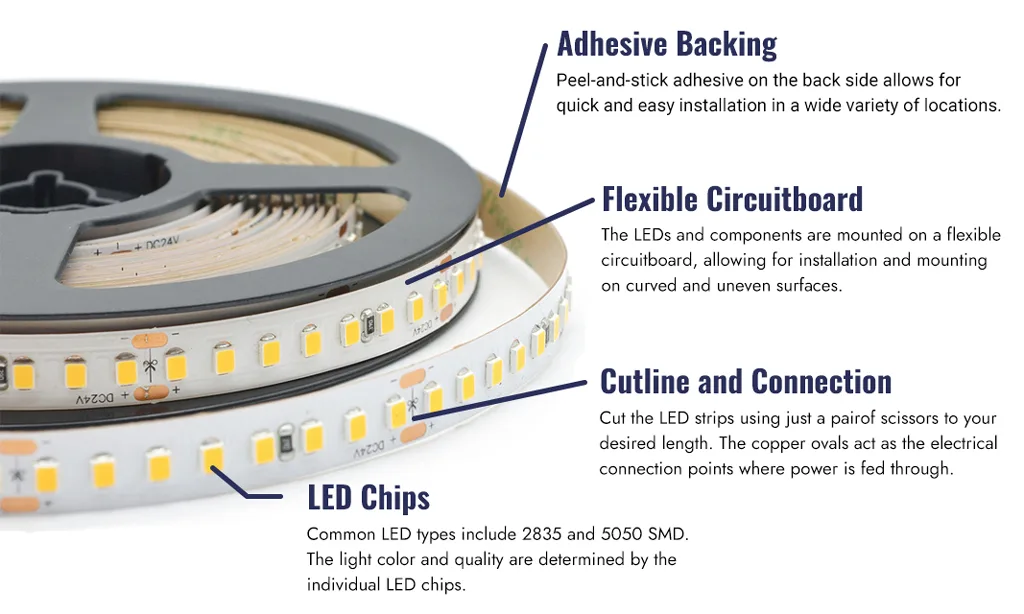
1. Definition and Structure:
LED strip lights—also known as LED tape lights—are ultra-flexible, low-profile lighting modules that integrate a series of light-emitting diodes (LEDs) along a bendable printed circuit board spaced at regular intervals along the strip. These lights are designed to provide efficient, high-quality lighting solutions in a wide range of settings, from home decor to commercial applications. The flexibility of these strips makes them versatile for mounting on both straight and curved surfaces, making them an ideal choice for a variety of design needs. The core structure consists of a printed circuit board (PCB) that holds the LEDs and allows the strips to be bent or shaped according to the project’s requirements.
The LEDs on the strip are typically mounted in parallel, ensuring that the light output is evenly distributed along the entire length of the strip. LED strip lights are most commonly available in low-voltage configurations, such as 12V or 24V, which offers a significant advantage in energy efficiency compared to traditional lighting systems. In addition, these low-voltage systems are safer for installation and often come with built-in features like thermal management to prevent overheating.
2. Variations and Features:
There are several different types of LED strip lights available, each tailored to different lighting needs. The key variations include:
RGB LED Strips: RGB strips are designed to combine red, green, and blue LEDs, allowing users to mix these colors in different intensities to create a wide spectrum of hues. RGB LED strips are ideal for projects that require dynamic color-changing effects, such as accent lighting, decorative displays, or event lighting. The ability to adjust the color mix allows for a highly customizable lighting experience, perfect for creating vibrant atmospheres or matching specific design themes.
RGBW LED Strips: RGBW strips are an advanced version of RGB strips that incorporate an additional white LED. This extra LED enables users to generate true white light alongside the RGB colors, making it a highly versatile option for lighting projects that require both colorful and neutral lighting. RGBW strips are particularly useful in environments where both mood lighting and high-quality white light are needed—such as in living spaces, kitchens, or offices where color-changing effects can complement general illumination.
COB LED Strips: COB (Chip on Board) LED strips feature a continuous line of LEDs embedded directly onto the flexible PCB. Unlike traditional LED strips, where individual LED chips are spaced apart, COB strips provide a smooth, uniform light output without visible “hotspots” or gaps between the LEDs. This design ensures more consistent brightness and a better overall visual effect, making COB strips ideal for applications where a high-quality, seamless light is required. These strips are particularly beneficial in situations like architectural lighting, backlighting, or areas that require even, diffused illumination.
3. Key Advantages of LED Strip Lights:
Energy Efficiency: LED strip lights consume significantly less power than traditional incandescent or fluorescent lighting, making them a more sustainable and cost-effective solution over time.
Customizability: Thanks to their flexible design, LED strips can be easily cut to fit a variety of spaces, allowing for highly customized installations. They can also be connected to create longer runs, providing even more versatility in design.
Ease of Installation: LED strips are often equipped with adhesive backing, allowing for straightforward, tool-free installation on most surfaces. This ease of installation makes them an excellent choice for DIY projects or for those with limited technical expertise.
Compact Design: The slim, discreet form factor of LED strip lights allows them to be used in spaces where traditional lighting solutions may not fit. They can be installed in tight spaces, corners, or along edges, enhancing their applicability across different design scenarios.
By providing a wide range of configurations and customization options, LED strip lights offer a flexible and energy-efficient solution for a variety of lighting needs. Whether you are looking to create ambient backlighting, dynamic color effects, or sleek, minimalistic under-cabinet lighting, LED strip lights are a versatile tool that allows designers and homeowners to bring their creative lighting ideas to life.
For more مصباح شريطي LED options, click here to explore our full product range.
Best Applications: LED Neon vs LED Strip for Indoor & Outdoor Projects
Understanding the key differences in where each type of LED lighting excels ensures that your project meets its specific needs for visual impact, durability, and efficiency. Although LED strip lights and LED neon flex lights may appear similar, they are designed for distinct applications.
1. LED Strip Lights – Best for Subtle, Functional, and Indoor Applications
LED strip lights are a versatile choice for indoor applications where cost-efficiency, ease of installation, and task or accent lighting are the primary goals. These strips provide a functional solution without compromising on quality. Here are some of their best uses:
Under-cabinet lighting for kitchens, retail counters, and office spaces, offering practical illumination without taking up valuable space.
Cove lighting that creates ambient lighting in ceilings or walls, perfect for enhancing the atmosphere in residential or commercial environments.
Backlighting for TVs, mirrors, and signage panels to provide an immersive experience without visible light sources.
Display shelf illumination in retail shops, museums, or showrooms, highlighting products or exhibits.
Interior architectural detailing in homes, hotels, and event venues, where flexibility in design is key.
Temporary event lighting where cost-effective, flexible lighting solutions are necessary and easily disposable.
LED strip lights are widely adopted in commercial interiors, residential upgrades, and custom millwork lighting, offering a cost-effective yet adaptable solution for tight spaces and concealed illumination. The visible LED dots are often not an issue as they can be hidden by diffusers or integrated into the design.
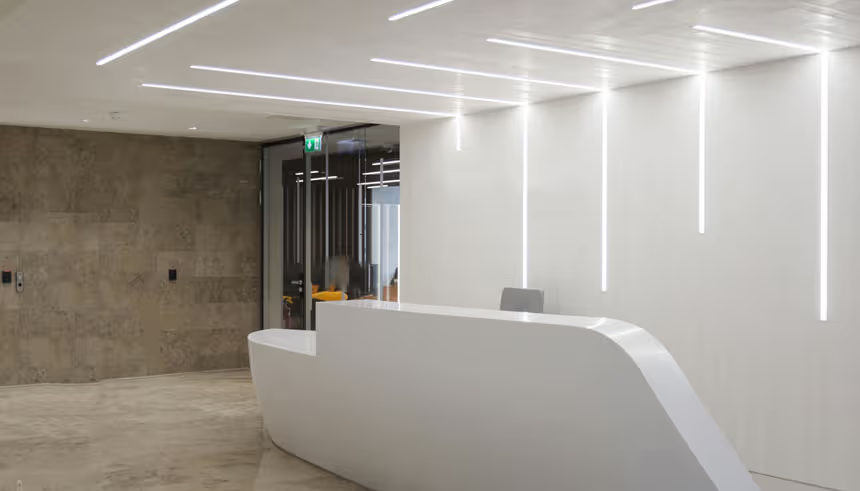
2. LED Neon Flex – Best for Visual Impact and Outdoor Architectural Applications
LED neon flex lights replicate the iconic look of traditional glass neon lights but offer all the benefits of energy-efficient LED technology. Known for their smooth, dot-free glow and durable build, they excel in environments that demand high visual impact and weather resistance. Ideal applications include:
Exterior building outlines and facade lighting, where bright, continuous light is essential for architectural elegance.
Architectural accent lighting on skyscrapers, bridges, and public installations, adding sophistication and visibility.
Retail signage and commercial branding that demands attention with bold, eye-catching visuals.
Art installations and creative light sculptures, offering a sleek and modern way to illuminate creative designs.
Long-distance linear lighting, where a consistent, bright output is required across large spans.
Outdoor landscape and perimeter lighting, with IP65–IP68 waterproof ratings ensuring reliable performance even in harsh weather.
Thanks to their robust weatherproof design, UV stability, and high mechanical strength, LED neon flex lights are the go-to solution for demanding outdoor projects where reliability, aesthetics, and longevity are non-negotiable where a long lifespan and consistent performance are needed.
For large-scale architectural lighting projects, such as building facades, signage outlines, or urban landscape enhancements, LED neon strips are often preferred due to their durability, seamless light output, and weather-resistant design.
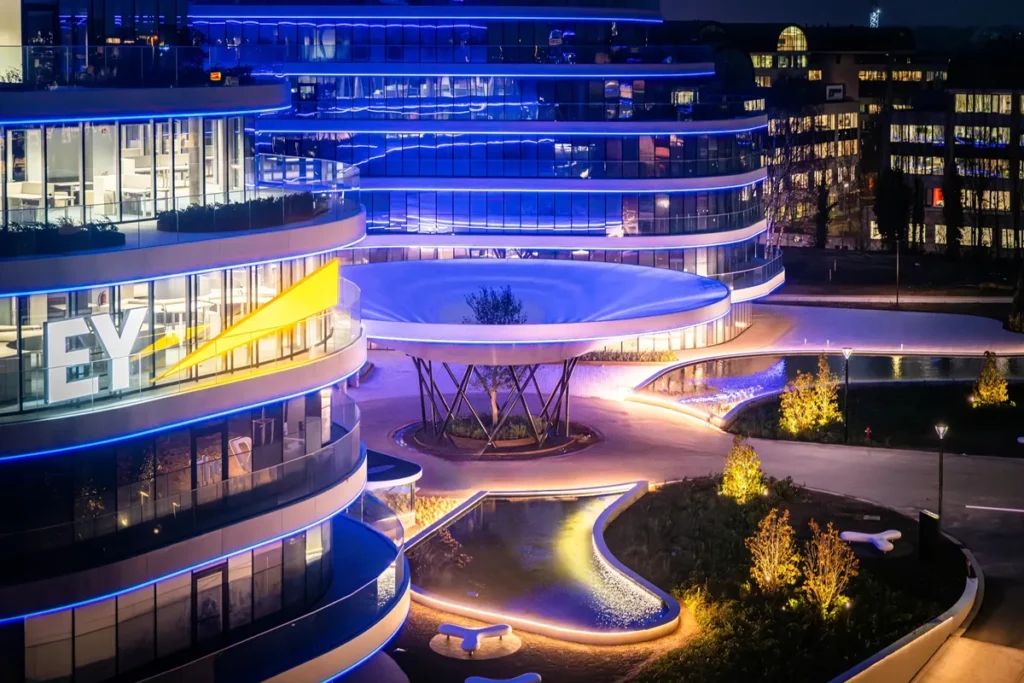
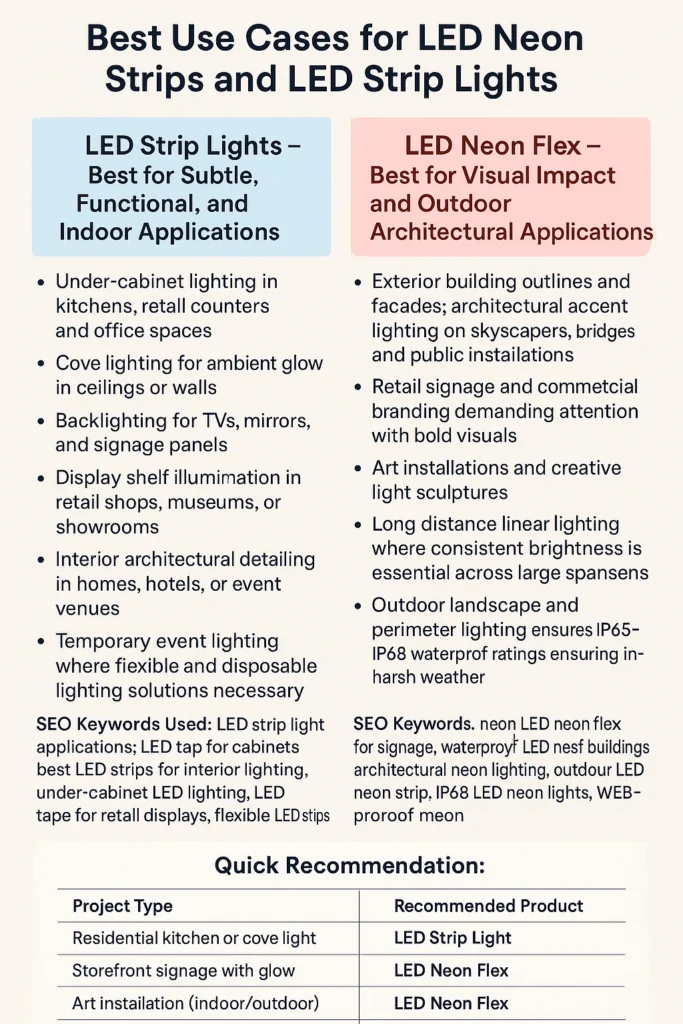
Outdoor Durability: Neon Flex vs LED Strip in Harsh Environments
For outdoor lighting applications, the ability to withstand moisture, dust, UV exposure, and temperature changes is essential. LED Neon Flex stands out with its robust, fully enclosed silicone or polyurethane body that typically offers IP65 to IP68 protection levels. This makes it well-suited for permanent outdoor installations like building outlines, bridges, and exposed signage. Its resistance to yellowing from UV rays and tolerance of extreme climates means it maintains both brightness and appearance over time, even in coastal or industrial environments.
In contrast, standard LED strip lights are often designed for indoor use, with limited weatherproofing even in higher-rated models. While some strips are coated for splash resistance, they typically cannot endure prolonged outdoor exposure. They may degrade under direct sunlight or fail in humid or rainy conditions. As a result, LED strips are better reserved for protected outdoor spots—like under eaves or inside weather-sealed enclosures—and for short-term setups such as seasonal decorations or exhibitions.
Installation: Bending, Shaping, and Mounting LED Neon & Strip Lights
LED strip lights are valued for their lightweight, slim profile and ease of installation. They can be bent around corners, cut to length, and attached using adhesive backing or mounting clips. This makes them ideal for tight spaces, furniture integration, or fast lighting upgrades. The strips are especially convenient in interior design projects where hidden light sources or precise placements are needed, and their low voltage operation makes wiring relatively simple.
LED Neon Flex, on the other hand, offers greater freedom when visual impact and continuous light output are the priorities. Though slightly more rigid than tape lights, it can be shaped into curves and letters using side-bend or top-bend designs, making it perfect for artistic lighting, signage, and architectural accents. Its solid housing also simplifies mounting on flat or curved surfaces using standard aluminum channels, ensuring a neat, professional appearance without visible hot spots or individual LED dots.
Moreover, for projects that require on-site adjustments, LED Neon Flex can be cut and reconnected with ease—making it a practical choice for custom installations or maintenance in the field.
Watch how simple it is to cut and rejoin LED neon strips in this demo video below.

Light Output: Dot-Free Glow vs Functional LED Chips
When it comes to visual appearance, LED Neon Flex delivers a clean, smooth, and uniform glow that closely mimics traditional glass neon. There are no visible LED dots, even when viewed up close, which gives it a polished, high-end look. This makes it especially effective for creating eye-catching outlines, signage, or decorative lighting in both indoor and outdoor settings. The light diffusion is consistent across the entire length, even over curves and corners, which enhances the overall aesthetic and avoids the patchy appearance that can occur with other lighting types.
While highly functional and easy to install, LED strip lights often expose individual diodes, which may result in visual hotspots unless integrated into diffuser profiles or recessed channels. This means they work best in applications where the light source is hidden or indirect—such as under shelves, behind panels, or inside coves. When used properly, they can provide excellent task lighting and ambient effects, but they aren’t the best choice when the lighting is meant to be seen directly or serve as a visual highlight. The overall light quality is functional, but not always visually refined without additional diffusing elements.
RGBW Control Options: Smart Control, DMX, and More
Both LED strip lights and LED neon flex come in a wide range of colors, including single-color (white, red, blue, etc.), RGB (red, green, blue), and RGBW (RGB plus white). However, LED neon flex typically delivers richer and more uniform color output, especially in dynamic lighting installations where smooth transitions and vibrant saturation are important. This makes it ideal for visual displays, signage, and environments that benefit from animated lighting effects.
From a control perspective, both LED strip lights and neon flex are compatible with standard dimmers and smart control platforms. However, LED neon flex is often engineered for advanced lighting protocols—such as DMX512, DALI, and SPI—making it ideal for synchronized lighting scenes, architectural facade lighting, and interactive installations requiring pixel-level precision. While standard LED strips can also support RGB controllers, they may require additional accessories to achieve complex lighting scenes. For projects involving architectural color washes or interactive lighting, neon flex offers greater flexibility and control consistency.
Maintenance and Lifespan: Which Lasts Longer?
LED neon flex is designed for longevity, often rated for 30,000 to 50,000 hours of continuous use. Its enclosed design helps prevent dust, moisture, and physical damage from affecting the internal LEDs, which significantly reduces the need for maintenance or early replacement. This reliability is especially important in hard-to-access installations or permanent outdoor fixtures where maintenance costs can add up quickly.
Standard LED strip lights can also achieve commendable lifespans—typically ranging from 25,000 to 35,000 hours—when installed in controlled indoor environments with proper voltage regulation and thermal management. However, their exposed or semi-exposed design means they’re more vulnerable to damage from heat, humidity, and physical wear. Over time, the adhesive backing may weaken, or individual LEDs may fade or fail, requiring spot replacements or rewiring. While easy to install, they may require more frequent attention compared to the robust structure of LED neon flex.
Voltage, Safety & Power Requirements
Both LED strip lights and LED neon flex typically operate on low-voltage systems, such as 12V or 24V DC, which makes them safer to install and handle than traditional high-voltage lighting. This is particularly advantageous in residential, commercial, or public environments where safety compliance is critical. Low-voltage lighting also minimizes the risk of electric shock during installation or maintenance.
That said, voltage matching and power supply sizing are critical for both LED neon flex and strip lights. Incorrect configurations can lead to voltage drop, thermal stress, or premature failure—especially in long-run or high-brightness installations. Overloading the strip or using an undersized power supply can lead to overheating, reduced lifespan, or even fire hazards. LED neon flex, due to its enclosed nature and more stable current distribution, tends to have better thermal management and protection against short circuits. It’s important to follow manufacturer guidelines for wiring, fusing, and power limits to ensure safe and efficient operation.
Energy Use: Comparing Power Draw & Environmental Impact
Energy efficiency is a key advantage of LED technology, and both LED strip lights and LED neon flex offer significant energy savings compared to traditional lighting. LED strip lights typically consume between 4W to 14W per meter depending on density and brightness. This makes them highly efficient for task lighting or ambient illumination, especially in projects where long operating hours are expected. Their low heat emission also contributes to overall energy savings in temperature-controlled environments.
Although LED neon flex typically consumes slightly more wattage per meter—owing to its integrated diffusers and durable housing—this additional power translates into superior light uniformity and enhanced visual presence, especially in large-scale outdoor deployments. However, this extra power often translates into better light uniformity and visibility, which can justify the slightly increased energy use in outdoor or branding applications. In terms of sustainability, both products use solid-state lighting with low environmental impact and long life cycles, reducing replacement waste and operating costs over time. Moreover, many high-quality LED solutions are now RoHS, CE and UL certified, supporting green building practices and energy-efficient project goals.
| الميزة | أضواء شريطية LED | ليد نيون فليكس |
| Visual Appearance | Exposed LEDs, may show hot spots | Smooth, dot-free light output |
| Weatherproofing | IP20–IP65 (limited) | IP67–IP68 (fully outdoor ready) |
| المرونة | Horizontally flexible | Multi-directional: top-bend, side-bend |
| التركيب | Requires profiles/diffusers | Simple brackets or channels |
| الصيانة | Easier to replace parts | Rarely needs repair |
| Control Systems | Basic RGB controllers, limited DMX | Full DMX, SPI, DALI compatibility |
| Best Use | Indoor accents, hidden lighting | Outdoor signage, façade, decorative lines |
| Estimated Lifespan | ~25,000–35,000 hours | ~30,000–50,000 hours |
Frequently Asked Questions (FAQ):
Q1: Which is better for outdoor use—LED neon flex or LED strip?
A: LED neon flex is better suited for outdoor applications. With IP67 or IP68 waterproof ratings, UV-resistant materials, and a fully enclosed silicone body, it offers long-term reliability in rain, sunlight, and even coastal environments. Standard LED strip lights may degrade quickly outdoors without proper protection.
Q2: Can I use LED strip lights for signage?
A: Yes, LED strip lights can be used for signage, especially for backlit channel letters or indoor lightboxes. However, they often produce visible light dots unless used with a diffuser. For signage where the light source is visible or where a continuous glow is desired, LED neon flex is a better choice due to its smooth, dot-free appearance.
Q3: How long do LED neon flex lights last?
A: High-quality LED neon flex products typically last between 30,000 and 50,000 hours. Thanks to their sealed design, they resist moisture, dust, and physical wear—resulting in fewer maintenance needs over time compared to traditional LED strips in similar conditions.
Final Verdict: Which LED Linear Light is Right for You?
The choice between LED strip lights and LED neon flex ultimately hinges on your project’s functional requirements, environmental conditions, and desired visual impact. If you’re looking for functional lighting in protected or indoor environments—such as accent lighting, under-cabinet illumination, or display shelves—LED strip lights offer versatility, simplicity, and a cost-effective solution. They’re easy to install and adaptable for many creative applications where the light source is not directly exposed.
On the other hand, if your project demands a smooth, continuous glow with high visual impact—especially for signage, outdoor features, or architectural outlines—LED neon flex provides unmatched durability, weather resistance, and professional appearance. Its ability to handle complex shapes and dynamic lighting makes it ideal for large-scale or permanent installations.
Ultimately, both products serve unique purposes. By understanding their differences in performance, design, and application, you can make a confident choice that enhances the success, safety, and style of your lighting installation.
Not Sure Yet? Here’s a Quick Side-by-Side Comparison
| Side-by-Side Feature Comparison of LED Neon Strip and LED Strip Lights | ||
| الميزة | أضواء شريطية LED | LED Neon Flex (Neon Strip) |
| Lighting Appearance | Exposed LED chips; may show hotspots | Dot-free, uniform glow with diffused surface |
| المرونة | Horizontally flexible, limited shape bending | Flexible in multiple directions (top/side/3D bending) |
| Weatherproofing | IP20–IP65 (indoor preferred) | IP67/IP68 (outdoor, wet, and UV-prone environments) |
| Visual Aesthetics | Technical look; needs profile for clean finish | Sleek finish; ideal for visible or decorative installs |
| التركيب | Requires aluminum profiles/diffusers for pro look | Clean install with simple brackets, fewer accessories |
| التخصيص | Easily cut and reconnected; DIY-friendly | Custom-cut requires sealing; better with factory prep |
| Control Compatibility | DMX, DALI, SPI, Bluetooth, basic smart control | Full control compatibility, ideal for dynamic lighting |
| خيارات الألوان | White, RGB, RGBW, COB, Tunable White | White, RGB, RGBW, Digital RGB, Tunable White |
| المتانة | Less durable; exposed components | High impact resistance, UV stable, enclosed design |
| التكلفة | Lower upfront cost | Higher cost but better ROI for visual/permanent projects |
| الصيانة | Easier to repair; more vulnerable in harsh environments | Less maintenance, more reliable in long-term applications |
| Project Type | Residential kitchen or cove light, Backlight for shelves or displays | Storefront signage with glow, Art installation (indoor/outdoor), Outdoor linear lighting for building |
Not sure which LED linear lighting solution aligns with your project scope? Speak with our lighting specialists today for tailored guidance.
Our experts at SignliteLED can guide you through the best solution—whether it’s for architectural lighting, signage, or custom installations.
Get a Quote Now or Explore All LED Neon Products.

